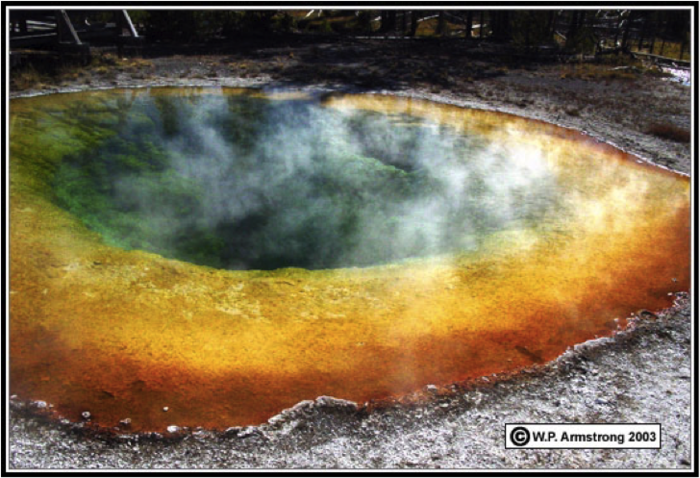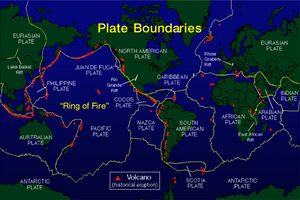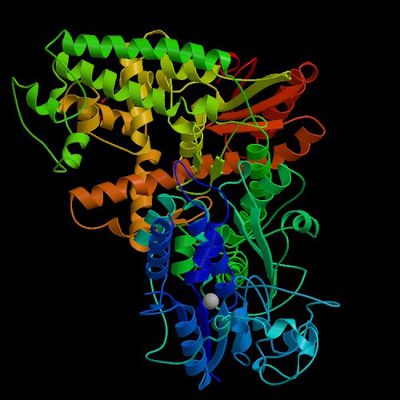Alkaline hot springs
Introduction
The alkaline hot spring, an area previously thought devoid of life, has now been found to be home to many diverse microbes. The conditions present in alkaline hot springs are very hostile and pose many challenges that need to be overcome in order to support life. The denaturation of enzymes occurs at high temperatures, as well as at both extremes of pH. Another problem is, again, the pH: microbes must devise a method where they can equilibrate the pH inside of their cell, or they will not be able to survive.
Properties of Alkaline Hot Springs
Physical environment
These habitats are found all over the world, especially in areas where geothermic or volcanic activity is high, such as Yellowstone National Park, which has over 10,000 hot springs alone. The Great Rift Valley in northeastern Africa is located at the junction of two separating plates, which has caused what is known as a rift valley, where the Earth's crust is very brittle and the heat from geothermic activity has caused a large amount of hot springs. Southern California is also located on a fault line, and areas like that are very likely to be volcanically active, thus causing both volcanoes and hot springs. Other places where hot springs are found include Nevada, Iceland, and many other areas distributed across the globe (Jones 1999).
Chemical environment
These hot springs are characterized by high levels of carbonates, chlorides, and silica compounds. Also, temperatures in these areas can be up to <100°C (Kruse, 1997). An alkali hot spring is an area where the pH is above 7 and can be as high as 11 or 12 (astrobio.net) and is heated by geothermic activity to temperatures as high as 650°C, however the normal temperature found in a hot spring, especially in areas where microbial habitats are found, is much lower, between 20-100°C (Pearson et. all, 2004). The large amount of silica material causes what are known as siliceous sinters, which can be the host of algal mats. In areas known as ‘travertine’, a high amount of CO2 gas dissolving rocks that contain a large amount of carbonate material. This area is usually found very close to areas with a large amount of limestone or dolostone (Kruse, 1997).
Other Alkaline Environments
Another environment where alkaliphilic bacteria and other organisms are known as soda lakes. These environments usually have an extremely high pH, ranging from 8.5 – 12. These extremely alkaline environments are found all over the world, such as the Great Rift Valley in northeastern Africa (Jones 1999). In order to survive in this type of ecosystem, many of the same adaptations are necessary. The bacteria present must be either alkaliphilic or alkalitolerant and must also possess alkaline-resilient enzymes like those present in the alkalithermophilic bacteria mentioned earlier.
Microbial communities
Microbes that can survive under these harsh conditions are known as alkalithermophilic and are mostly chemolithoautotrophic (Zhang, 2005). Microorganisms found in these habitats are both autotrophic and heterotrophic. Often times, the microbes will form microbial mats in the hot spring. The blue-green algae Synechococcus lividus will cooperate with Chloroflexus aurantiacus, also a photosynthetic bacterium, to form a microbial mat, where the layers are stratified so as to undergo photosynthesis where light and oxygen levels permit, and to undergo decomposition under dark, anaerobic or aerobic conditions. The cyanobacteria S. lividus provides the C. aurantiacus with the byproducts of the photosynthetic process, which helps to sustain both of their existence (Vesteinsdottir, 2008). However, photosynthetic processes cease at temperatures above approximately 70°C and at this temperature, the cyanobacteria can no longer exist. This is the cause for the differentiation of the colors in hot springs. Where cyanobacteria can form, orange, green, blue, and purple coloration can occur due to the presence of a multitude of diverse cyanobacteria. Above approximately 70°C, thermophilic, heterotrophic bacteria and archaea dominate.
Adaptations
Thermophiles
In order to survive in these harsh environments, microbes needed to develop specialized enzymes that can withstand such high temperatures such as the enzyme known as Taq polymerase, which is found in the bacterium known as Thermus aquaticus, and is able to withstand denaturation caused by the extreme temperatures. This is accomplished through a different amino acid chain structure, where there are a greater number of ionic bonds between individual amino acids. Another adaptation necessary for survival in such a harsh environment is the addition of saturated fatty acids in the cytoplasmic membrane. This adaptation makes the cell much more resilient to the extreme temperatures. It was previously thought that bacteria, and life in general, could not exist over 80°C due to the fact that DNA would unravel; however, bacterial organisms have found ways to survive up to 160°C (Jarrett). These bacteria are found in a very diverse range of natural habitats, like hydrothermal vents at the bottom of the ocean, hot springs, and fumaroles.
Alkaliphiles
In order to cope with the alkaline conditions, alkaliphilic microbes have many adaptations including the presence of cytoplasmic polyamines with charged amino acids, which allow buffering from extremely alkaline environments. In Bacillus spp., it has been observed that, in addition to peptidoglycan, there are acidic compounds such as galacturonic acid, gluconic acid, glutamic acid, aspartic acid, and phosphoric acid that act as buffers to the alkaline environment, allowing uptake of hydronium ions and exclusion of hydroxide ions (Horikoshi 1999). This is known as passive regulation. Some microbes also actively maintain the pH of their cytoplasm by using sodium ion channels that take in Na+. When there is a buildup in the cytoplasm of Na+, the sodium ions are exported from the cell in exchange for hydrogen ions, which keeps the cell in equilibrium (Zhang, 2005).
Key Microorganisms
The organisms that are most prevalent and have the largest impact on the alkaline hot spring habitat include alkalithermophilic bacteria such as Synechococcus lividus, Chloroflexus aurantiacus, Thermoproteus, Thermophilum, Desulforococcus, Thermosyntropha lipolytica, Thermoanaerobacter ethanolicus and Sulfolobus. Many alkaliphilic bacteria, however, have not been identified completely, many are simply known as Bacillus spp.
Microbial processes
The most common substrate in the alkaline hot springs is hydrogen and sulfur. The oxidation of hydrogen in the presence of oxygen forms water and the enzyme hydrogenase is required. In the oxidation of sulfur, the enzyme sulfite oxidase or sulfide dehydrogenase is required to produce hydrogen sulfide (Horikoshi 1999). Heterotrophic bacteria that oxidize an inorganic substrate as a means survival, especially in thermic, alkaline environments include Thermoproteus, Thermophilum, Desulforococcus, and Sulfolobus (Vesteinsdottir, 2008).
Organic Decomposition
In addition to hydrogen and sulfuric compounds, organic compounds are also a large component of the alkaline hot springs ecosystem. Organic matter from can come from several sources, most importantly, the decomposition of dead bacterial, archaeal and fungal matter. Also, allochthonous sources provide a portion of the dissolved organic carbon (DOC) (Kritzberg et al. 2004).
Methanogenesis
In the absence of oxygen, the oxidation of hydrogen can proceed using carbon dioxide as the terminal electron acceptor, producing methane and water. This process is known as methanogenesis and it is carried out by a multitude of archaea known as methanogens and occurs in hot springs via several pathways. Archaea can use the hydrogen gas if it is present, however when the substrate is unavailable, archaea can produce methane through the decomposition of microbial mat organic matter (Ward 1977).
Current Research
Crenarchaeota can be an indicator of the conditions of these specific environments. Using sampling techniques to isolate the Crenarchaeota from the surrounding population and identifying a compound known as Glycerol dialkyl glycerol tetraethers (GDGTs). GDGTs are thought to correlate positively with temperature, however these archaea are believed to inhabit a large distribution of habitats with diverse physical conditions (Schouten et al., 2007).
The enzymes present in alkaliphilic microbes are often times used in detergents, particularly alkaline protease. This enzyme is used to cut peptide chains through the process of proteolysis. Often times, this enzyme, along with alkaline cellulases, amylases, and lipases are used in cleaning products, and because these enzymes are adapted to alkaline environments, they will remain functional even in extremely high pH solutions like laundry detergent (Fujinami 2010). Another enzyme currently used broadly in modern research is the Taq polymerase, from the bacterium Thermus aquaticus which is a thermally stable DNA polymerase utilized extensively in the polymerase chain reaction (PCR) (Jarrett).
The implications of alkalithermophilic bacteria and archaea is also the premise for life on other planets and moons, like Europa. There is growing proof that bacteria can survive under even the harshest conditions like extreme heat or super alkaline environments like those found in alkaline hot springs, soda lakes, and soda deserts (Jarrett).
References
Armstrong, W. P. "Archaebacteria: Life On Mars?" WAYNE'S WORD. 3 Dec. 2010. Web. <http://waynesword.palomar.edu/ploct97.htm>.
Doemel, W. "Structure, Growth, and Decomposition of Laminated AlgalBacterial Mats in Alkaline Hot Springs." Applied and Environmental Microbiology 34.4 (1977): 433-52. Print.
Fujinami, S., and M. Fujisawa. "Ndustrial Applications of Alkaliphiles and Their Enzymes--past, Present and Future." Environmental Technology 9th ser. 31.8 (2010): 845-56.
Horikoshi, Kokie. "Alkaliphiles: Some Applications of Their Products for Biotechnology." American Society for Microbiology 63.4 (1999): 735-50. Print.
Jarrett. "Thermophiles." Reading. Http://spider.ipac.caltech.edu/. Web.
Jones, B. E., and W. D. Grant. "Microbial Diversity and Ecology of the Soda Lakes of East Africa." Ecology and Diversity of Extremophiles.
Kevbrin, Romanek, and Wiegel. "ALKALITHERMOPHILES: A DOUBLE CHALLENGE FROM EXTREME ENVIRONMENTS." Alkalithermophiles: 1-16.Http://www.as.uky.edu/. Web. 5 Apr. 2011.
Kritzberg, Emma, Jonathon Cole, Wilhelm Graneli, and Darren Bade. "Autochthonous versus Allochthonous Carbon Sources of Bacteria: Results from Whole-lake 13 C Addition Experiments." Limnol Oceanography (2004): 588-96. Http://www.limnol.lu.se/.
Kruse, F. A. "CHARACTERIZATION OF ACTIVE HOT-SPRINGS ENVIRONMENTS USING MULTISPECTRAL AND HYPERSPECTRAL REMOTE SENSING."Analytical Imaging and Geophysics (1997).
Pearson, A., Z. Huang, A. E. Ingalls, C. S. Romanek, J. Wiegel, K. H. Freeman, R. H. Smittenberg, and C. L. Zhang. "Nonmarine Crenarchaeol in Nevada Hot Springs."Applied and Environmental Microbiology 70.9 (2004): 5229-237.
Ulukanli, Zeynep, and Metin Digrak. "Alkaliphilic Micro-organisms and Habitats." Turk J Biol26 (2002): 181-91.
Vesteinsdottir, Hildur. "Physiological and Phylogenetic Studies of Thermophilic, Hydrogen, and Sulfur Oxidizing Bacteria Isolated from Icelandic Geothermal Areas." University of Akureyri (2008): 1-106. Http://skemman.is/. Web. 5 Apr. 2011.
Ward, David. "Thermophilic Methanogenesis in a Hot-Spring Algal-Bacterial Mat (71 to 30°C)." Applied and Environmental Microbiology 35.6 (1977): 1019-026.Http://www.ncbi.nlm.nih.gov/.
Zhang. "Microbial Life in Alkaline Environments." Microbial Life Educational Resources. Science Education Resource Center.
Edited by Adam Perri, a student of Angela Kent at the University of Illinois at Urbana-Champaign.



